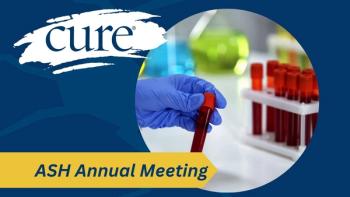
The Future of Frontline Therapy in CLL

Transcript:
Kristie L. Kahl: Can discuss the tests that are conducted in newly diagnosed patients and moreover which tests patients should be asking for?
Dr. Susan O’Brien: Thetests that we usually are going to do once the diagnosis is made are to look at prognostic factors. What I mean by that are tests where you're looking to try and predict how people's disease is going to progress because this is a cancer where we don't necessarily treat at the time it's diagnosed because many patients can live many years and be totally asymptomatic with CLL but they often want to have some expectation for the course of their disease. There are a number of prognostic factors. FISH is one and that stands for fluorescent in situ hybridization and it's just a test to look for common normalities that are seen in CLL cells. We also sometimes look at levels of certain proteins in the cell like CD38 or zap70. We do a test called beta2 microglobulin and then we have another test we do that looks at what's called IgVH mutation status. The IgVH is a gene inside the CLL cell in about half of patients. All of those together can help us predict disease progression.
Now there are some people who will argue well if you're not going to use the test to make treatment decisions do you even really need to get them at the time of diagnosis and the simple answer is it really depends on how comfortable the patient is not having those results or do they really want to get those results because it is true that if you've already decided the patient's asymptomatic and you're planning to carry out a watch-and-waitstrategy, you might not need the test because you're not acting on them.
You need them, in particular the chromosome test as well as a mutation status, if you're going to treat and that's because there are some abnormalities, for example, a chromosome abnormality called 17p deletion where those patients do not respond at all well to chemotherapy. So, if you knew that that abnormality was there immediately that would no longer be an option for therapy. So, it's very important that we get them at the time of therapy.
The other important point is the chromosomes can change so even if we have a patient who got tested when they were newly diagnosed for the chromosome analysis and then three years later they've progressed enough to warrant treatment, it's very important to check the chromosomes again. The mutation status does change and so not only do we need to repeat them at the time of therapy initiation but if we treat a patient and they stay in remission for a couple of years and then the disease recurs, it's also important again before initiating treatment to check the FISH at that time.
We also have another test looking for what's called a p53 mutation. That's different from the immunoglobulin mutation test and the reason that's important is the two groups that we never want to give chemotherapy to are those with the 17p deletion and those with the p53 mutation. Those are really crucially important to be tested basically any time a patient is going to get treatment.
Kristie L. Kahl: Cancer treatment over the last decade has expanded exponentially, but in particular with CLL, how has the initial treatment for this disease evolved?
Dr. Susan O’Brien: It has evolved and that's because up until really just about five years ago all of our treatments for CLL were chemotherapy based either with mild chemotherapies that we might use in older patients with a lot of comorbidities who might be failure or somewhat more aggressive chemotherapies that generally produce longer remissions but are better tolerated by younger patients. I would still say there is a role for chemotherapy but we certainly have moved further and further away from it because we now have what we call the small molecules, which are not chemotherapeutic agents.
They are agents generally which will interfere with a protein function inside the CLL cell and by interfering with that function help kill off the cell. They're generally oral. It doesn't mean that they don't have side effects but the side effects are different than chemotherapy and in general these novel small molecules are very well tolerated, particularly in older patients who have much more difficulty with chemotherapy so we have still have chemotherapy as an option. But now we have three small molecules which have been approved to be used in CLL up front. (Imbruvica [ibrutinib]) another similar drug called (Calquence [acalabrutinib]) and another drug called (Venclexta [venetoclax]). In some cases, we give these drugs with an antibody treatment and in some cases we don't. There is another class of drugs called the PI3K inhibitors that are oral agents, and there's two drugs – (Zydelig [idelalisib]) and (Copiktra [duvelisib]) – in CLL, but those are only approved for patients whose disease has recurred. We have three small molecule options in the upfront setting for initial therapy.
Kristie L. Kahl: Are those considered standard of care?
Dr. Susan O’Brien: There are a fraction of patients who still would be good candidates for chemo but all of them can be considered standard in that all of them have been FDA approved to be used as an initial therapy.
Kristie L. Kahl: Does chemo-immunotherapy still have a role in treatment?
Dr. Susan O’Brien: Yes, Ishould clarify what i said about chemotherapy. I actually meant chemo immunotherapy. So what is the distinction there? Basically all of our chemotherapy regimens are given in combination with an antibody. So an antibody is not chemo, it's a protein that's designed to sort of latch onto the CLL cell, kind of like a lock and key, and when it does that it helps the chemo kill the cell. The chemotherapies that we use in CLL, the three main ones are calambisol, which is a really mild one and can be given by mouth. And then two intravenous ones bendamastine and fludarabine. All of those are given in combination with antibodies.
So really chemotherapy by itself is gone. Over the years, it has evolved to be chemo immunotherapy.
Kristie L. Kahl: What are some exciting drugs or combination regimens that are in the pipeline?
Dr. Susan O’Brien: Well we have exciting ones that we can use right now. I mentioned we have ibrutinib, we can use a calibrate which can be given with or without antibody and we have venetoclax, which is usually given with an antibody called (Gazyva [Obinutuzumab]) and those are producing really great results. They’re very new. For example, (Calquence [acalabrutinib]) only had an approval within the past year. (Venclexta [venetoclax]) and (Gazyva [obinutuzumab]) only had a frontline approval in the past year and a half.
In terms of the horizon, we're kind of on the horizon right now because these treatments have only been approved in the past year or so and we expect them to produce very durable remissions. I can't even tell you what the average remission is going to be other than I know it's going to be based on years. Thisis how our treatments have expanded. You said exponentially, but just within the last year and a half, we've gone from having one small molecule to having three of them at our disposal.
Kristie L. Kahl: What do patients have to look forward to in the future?
Dr. Susan O’Brien: Well there are other interesting molecules that are in development. There are CAR Ts, which I think most patients have heard about. There's not yet a CAR-T cell therapy approved by the FDA in CLL.
There's something else called bi-specific antibodies, which are very interesting molecules because what they do is their antibodies that bind to the target. So in this case, the CLL cell. Butthen they also bind to the patient's own Tcells and what they actually serve to do is to redirect the patient's own T cells, which is a component of their immune system and get it to attack the CLL cells. So, kind of like CAR T, but using the patient's own t cells with a drug or an antibody that we give them.
There's also a class of drugs called antibody drug conjugates. We don't have one yet in CLL and the idea behind that is you take the antibody which again binds to the CLL cell, but on the other end of the antibody is essentially a toxin or a poison. But you would not be able to treat the leukemia because it would make them sick, but because you give it attached to the antibody it only goes into the cell that the antibody is binding to. So you actually direct that poison right on to the CLL cell. That’s another very interesting class of drugs where we yet don't have any available in CLL. So even though we have these new great drugs, we have all these other classes which also may lead to subsequent therapies for CLL.
Transcription edited for clarity.




